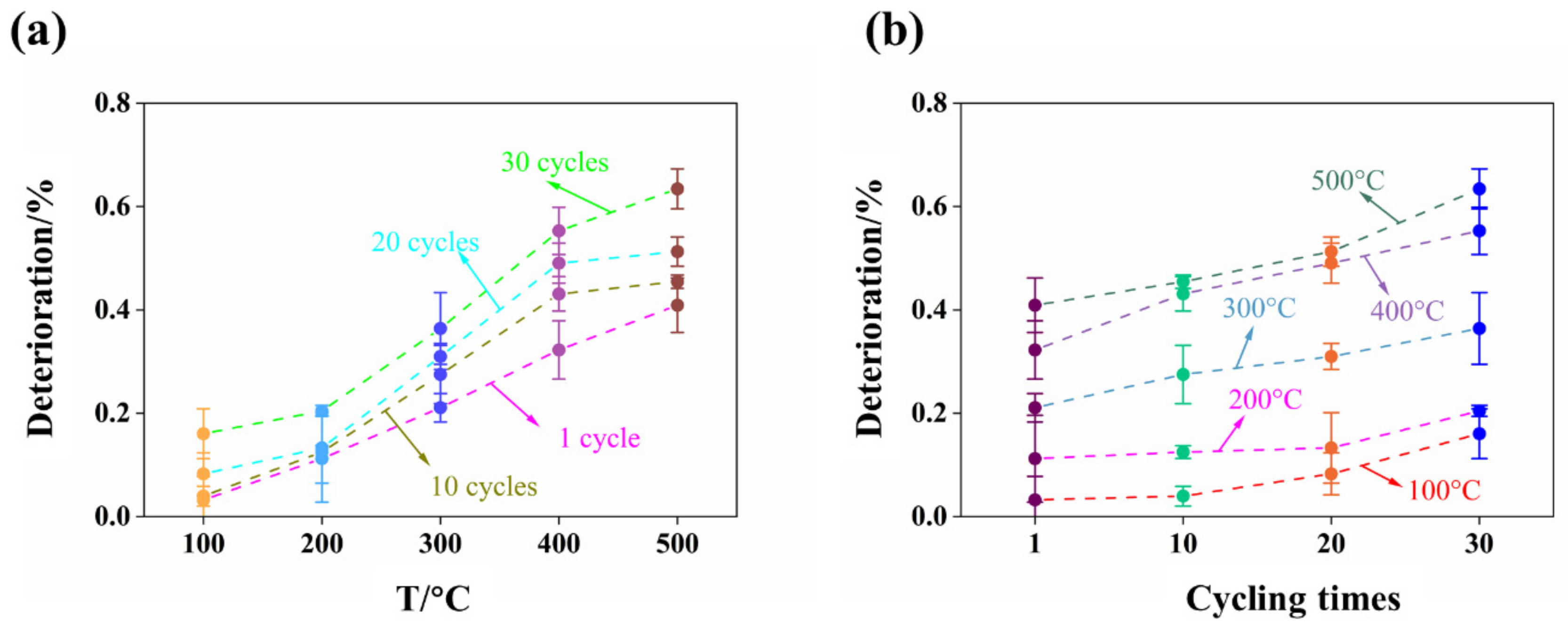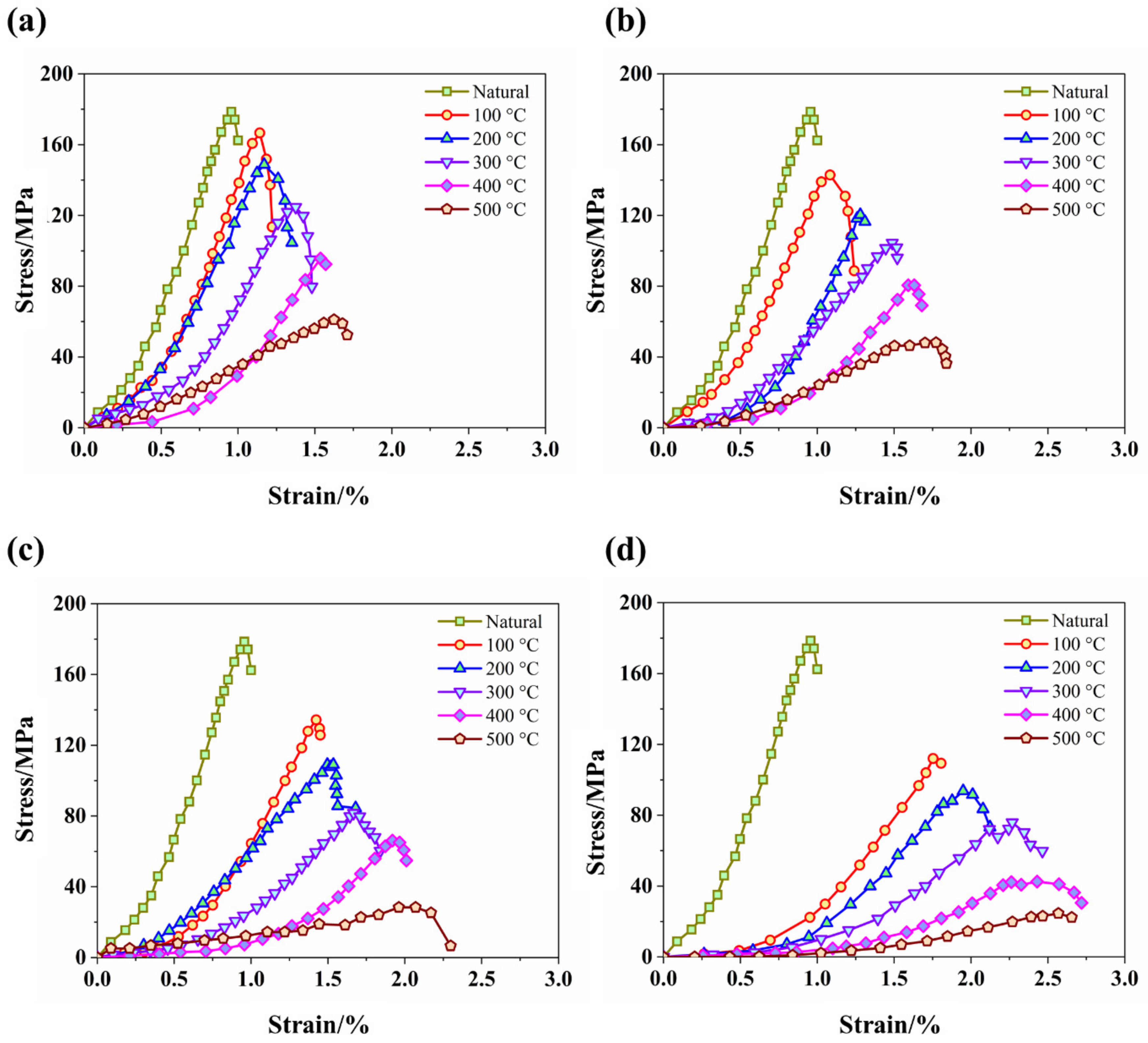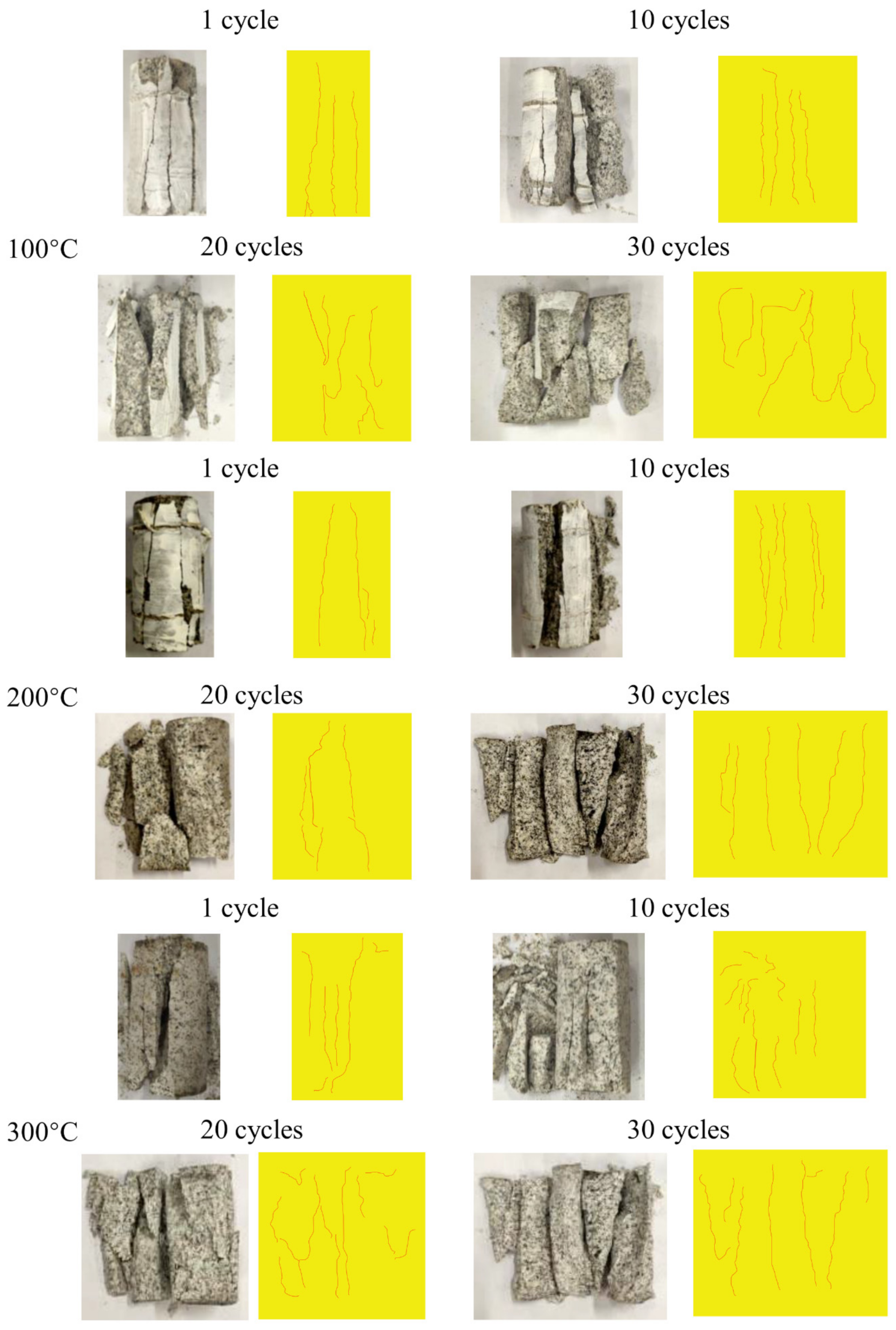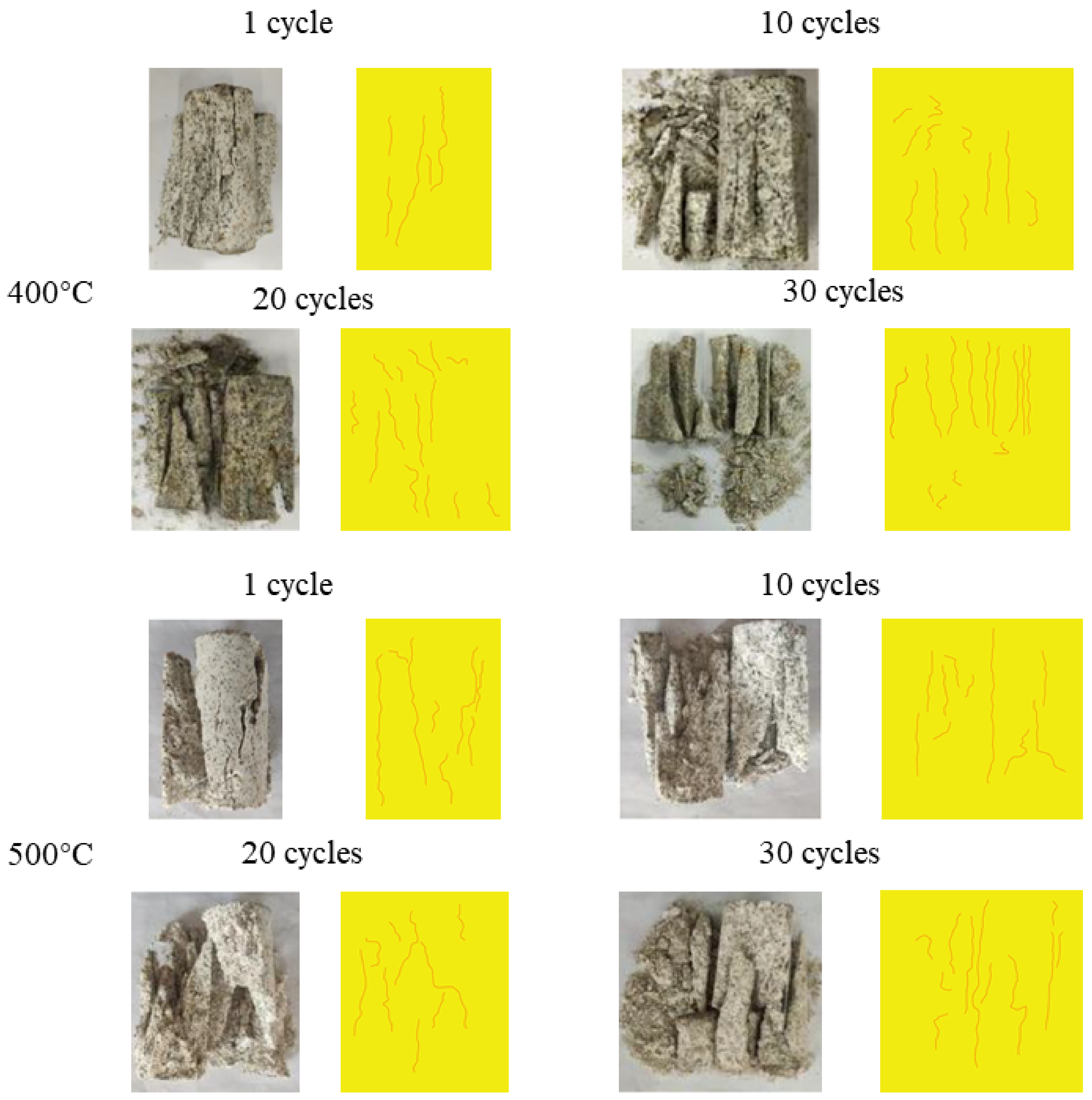On the Microcrack Propagation and Mechanical Behavior of Granite Induced by Thermal Cycling Treatments
Abstract
:1. Introduction
2. Experimental Material and Methodology
2.1. Specimen Preparation
2.2. Physical Property Tests
2.3. Microcrack Observation
2.4. Thermal Cycling Procedure
- The dry samples were heated in a muffle furnace from room temperature (23 °C) to the predefined temperature, which varied from 100 to 500 °C, at intervals of 100 °C. The heating rate was controlled at 2 °C to avoid potential temperature gradients and thermal shock within the sample. In addition, after reaching the target temperature, the samples were held isothermally in the furnace for more than 2 h to ensure temperature uniformity.
- The heated samples were taken out of the furnace and exposed naturally to the open atmosphere until reaching room temperature. This cooling treatment allowed the samples to cool with a gentle cooling rate. At this point, one thermal cycling treatment was complete.
- Four levels of thermal cycles (i.e., 1, 10, 20, and 30) were set in this study to investigate the influence of thermal cycling times on the microcrack propagation and mechanical behaviors of granite rock. Subsequently, the aforementioned physical property tests and SEM were conducted on the granite samples after each of the five thermal cycles finished.
2.5. Mechanical Property Tests
3. Results
3.1. Mass, Volume, and Bulk Density
3.2. Ultrasonic Wave Propagation
3.3. Stress–Strain Curves
3.4. UCS and Elastic Modules
4. Discussion
4.1. Microcrack Propagation
4.2. Failure Mode
5. Conclusions
- (1)
- The mass, volume, and P-wave velocity of the granite rock subjected to thermal cycling treatment are significantly influenced by the treated temperature and thermal cycling times. When the granite rocks are subjected to higher temperature and more frequent thermal cycling treatment, the mass, density, and P-wave velocity of the samples decrease more seriously, while the volume of the samples increases significantly.
- (2)
- The mechanical property of the granite rocks is highly influenced by thermal cycling treatment. The UCS and elastic modulus of the granite samples both present a negative relationship with the treated temperature and thermal cycling times. The UCS and elastic modulus of the granite declined from 178.65 MPa and 20.09 GPa to 24.58 MPa and 3.81 GPa after being treated at 500 °C for 30 thermal cycling times, respectively. Additionally, the UCS and elastic modulus of the granite samples subjected to thermal cycling treatment can be characterized by the heating temperature and the thermal cycling times.
- (3)
- Both intergranular cracks and transgranular cracks can be observed in the granite rock after thermal cycling treatment by SEM. Moreover, transgranular cracks can be produced in the granite rock by high temperature and frequent thermal cycling treatment. The temperature gradient and thermal shock induced by thermal cycling treatment are the main reason for the microcrack propagation within the samples and the degradation of the mechanical performance of the granite rocks.
- (4)
- Thermal cycling treatment can significantly influence the macrofracture network in the samples and the failure mode of the granite rocks under uniaxial compression loads. After the granite rocks are subjected to high temperature and frequent thermal cycling treatment, the density of the macrofracture network grows gradually, and the failure mode of the granite samples is transformed from axial splitting to shear failure. In addition, the property of the granite rocks can be reversed from brittleness to ductility.
Author Contributions
Funding
Institutional Review Board Statement
Data Availability Statement
Acknowledgments
Conflicts of Interest
References
- Oettingen, M.; Skolik, K. Numerical design of the Seed-Blanket Unit for the thorium nuclear fuel cycle. E3S Web Conf. 2016, 10, 00067. [Google Scholar] [CrossRef] [Green Version]
- Oettingen, M.; Cetnar, J. Numerical modelling of modular high-temperature gas-cooled reactors with thorium fuel. Nukleonika 2021, 66, 133–138. [Google Scholar] [CrossRef]
- Zhang, Y.; Zhao, G.-F. A Global Review of Deep Geothermal Energy Exploration: From a view of Rock Mechanics and Engineering. Geomech. Geophys. Geo-Energy Geo-Resour. 2020, 6, 4. [Google Scholar] [CrossRef]
- Gamboa, M.; Iribarren, D.; Dufour, J. On the Environmental Suitability of High- and Low-enthalpy Geothermal Systems. Geothermics 2015, 53, 27–37. [Google Scholar] [CrossRef]
- Duchane, D.V. Geothermal Energy from Hot Dry Rock: A Renew able Energy Technology Moving towards Practical Implementation. Renew. Energy 1996, 9, 1246–1249. [Google Scholar] [CrossRef]
- Jasmin, R.; Hubert, L.; Antonie, C.; Malo, M. Temperature Dependence of Rock Salt Thermal Conductivity: Implications for Geothermal Exploration. Renew. Energy 2022, 184, 26–35. [Google Scholar]
- Tomac, I.; Sauter, M. A Review on Challenges in the Assessment of Geomechanical Rock Performance for Deep Geothermal Reservoir Development. Renew. Sustain. Energy Rev. 2018, 82, 3972–3980. [Google Scholar] [CrossRef]
- Kuriyagawa, M. Hot Dry Rock Geothermal Energy Development Project at Los Alamos, USA. J. Geotherm. Res. Soc. Jpn. 1984, 6, 87–99. [Google Scholar]
- Zhao, Y.; Feng, Z.; Xi, B.; Wan, Z.; Yang, D.; Liang, W. Deformation and Instability Failure of Borehole at High Temperature and High Pressure in Hot Dry Rock Exploitation. Renew. Energy 2015, 77, 159–165. [Google Scholar] [CrossRef]
- Feng, C.; Wang, H.; Jing, Z. Investigation of Heat Extraction with Flowing CO2 from Hot Dry Rock by Numerical Study. Renew. Energy 2021, 169, 242–253. [Google Scholar] [CrossRef]
- Chen, Y.; Zhao, Z.; Peng, H. Convective Heat Transfer of Water Flow in Intersected Rock Fractures for Enhanced Geothermal Extraction. J. Rock Mech. Geotech. Eng. 2022, 14, 108–122. [Google Scholar] [CrossRef]
- Isaka, B.L.A.; Gamage, R.P.; Rathnaweera, T.D.; Perera, M.S.A.; Chandrasekharam, D.; Kumari, W.G.P. An Influence of Thermally-Induced Micro-Cracking under Cooling Treatments: Mechanical Characteristics of Australian Granite. Energies 2018, 11, 1338. [Google Scholar] [CrossRef] [Green Version]
- Yang, S.-Q.; Hu, B. Creep and Long-Term Permeability of a Red Sandstone Subjected to Cyclic Loading After Thermal Treatments. Rock Mech. Rock Eng. 2018, 51, 2981–3004. [Google Scholar] [CrossRef]
- Ren, H.; Zhuang, X.; Rabczuk, T. Dual-horizon Peridynamics: A Stable Solution to Varying Horizons. Comput. Methods Appl. Mech. Eng. 2017, 318, 762–782. [Google Scholar] [CrossRef] [Green Version]
- Wang, P.; Yin, T.; Li, X.; Zhang, S.; Bai, L. Dynamic Properties of Thermally Treated Granite Subjected to Cyclic Impact Loading. Rock Mech. Rock Eng. 2019, 52, 991–1010. [Google Scholar] [CrossRef]
- Yin, T.; Bai, L.; Li, X.; Li, X.; Zhang, S. Effect of Thermal Treatment on the Mode I Fracture Toughness of Granite under Dynamic and Static Coupling Load. Eng. Fract. Mech. 2018, 199, 143–158. [Google Scholar] [CrossRef]
- Rabczuk, T.; Ren, H. Peridynamic Formulation for the Modelling of Quasi-static Fractures and Contacts in Brittle Rocks. Eng. Geol. 2017, 225, 42–48. [Google Scholar] [CrossRef]
- Yuan, H.; Sun, Q.; Geng, J.; Ge, Z.; Yuan, S. Acoustic Emission Characteristics of High-temperature Granite through Different Cooling Paths. Geomech. Geophys. Geo-Energy Geo-Resour. 2022, 8, 97. [Google Scholar] [CrossRef]
- Gomah, M.E.; Li, G.; Sun, C.; Xu, J.; Yang, S.; Li, J. On the Physical and Mechanical Responses of Egyptian Granodiorite after High-Temperature Treatments. Sustainability 2022, 14, 4632. [Google Scholar] [CrossRef]
- Yin, Q.; Wu, J.; Jiang, Z.; Zhu, C.; Su, H.; Jing, H.; Gu, X. Investigating the Effect of Water Quenching Cycles on Mechanical Behaviors for Granites after Conventional Triaxial Compression. Geomech. Geophys. Geo-Energy Geo-Resour. 2022, 8, 77. [Google Scholar] [CrossRef]
- Zhao, G.; Guo, Y.; Chang, X.; Jin, P.; Hu, Y. Effects of Temperature and Increasing Amplitude Cyclic Loading on the Mechanical Properties and Energy Characteristics of Granite. Bull. Eng. Geol. Environ. 2022, 8, 155. [Google Scholar] [CrossRef]
- Sun, Q.; Zhang, W.; Pan, X.; Zhang, Y. The Effect of Heating/cooling Cycles on Chrominance, Wave Velocity, Thermal Conductivity and Tensile Strength of Diorite. Environ. Earth Sci. 2019, 78, 403. [Google Scholar] [CrossRef]
- Vagnon, F.; Colombero, C.; Colombo, F.; Comina, C.; Ferrero, A.M.; Mandrone, G.; Vinciguerra, S.C. Effects of Thermal Treatment on Physical and Mechanical Properties of Valdieri Marble—NW Italy. Int. J. Rock Mech. Min. Sci. 2019, 116, 75–86. [Google Scholar] [CrossRef]
- Wu, X.; Huang, Z.; Cheng, Z.; Zhang, S.; Song, H.; Zhao, X. Effects of Cyclic Heating and LN2-cooling on the Physical and Mechanical Properties of Granite. Appl. Therm. Eng. 2019, 156, 99–110. [Google Scholar] [CrossRef]
- Villarraga, C.J.; Gasc-Barbier, M.; Vaunat, J.; Darrozes, J. The Effect of Thermal Cycles on Limestone Mechanical Degradation. Int. J. Rock Mech. Min. Sci. 2018, 109, 115–123. [Google Scholar] [CrossRef]
- Rong, G.; Peng, J.; Cai, M.; Yao, M.; Zhou, C.; Sha, S. Experimental Investigation of Thermal Cycling Effect on Physical and Mechanical Properties of Bedrocks in Geothermal Fields. Appl. Therm. Eng. 2018, 141, 174–185. [Google Scholar] [CrossRef]
- Peng, J.; Rong, G.; Yao, M.; Wong, L.N.Y.; Tang, Z. Acoustic Emission Characteristics of a Fine-grained Marble with Different Thermal Damages and Specimen Sizes. Bull. Eng. Geol. Environ. 2018, 78, 4479–4491. [Google Scholar] [CrossRef]
- Fan, L.F.; Gao, J.W.; Wu, Z.J.; Yang, S.Q.; Ma, G.W. An Investigation of Thermal Effects on Micro-properties of Granite by X-ray CT Technique. Appl. Therm. Eng. 2018, 140, 505–519. [Google Scholar] [CrossRef]
- Fairhurst, C.E.; Hudson, J.A. Draft ISRM Suggested Method for the Complete Stress-strain Curve for Intact Rock in Uniaxial Compression. Int. J. Rock Mech. Min. Sci. 1999, 36, 279–289. [Google Scholar]
- Yang, S.Q.; Ranjith, P.G.; Jing, H.W.; Tian, W.L.; Ju, Y. An Experimental Investigation on Thermal Damage and Failure Mechanical Behavior of Granite after Exposure to Different High Temperature Treatments. Geothermics 2017, 65, 180–197. [Google Scholar] [CrossRef]









| T/°C | 1 Cycle | 10 Cycles | 20 Cycles | 30 Cycles | ||||||||||||||||||||
|---|---|---|---|---|---|---|---|---|---|---|---|---|---|---|---|---|---|---|---|---|---|---|---|---|
| Mass (g) | Volume (cm−3) | Density (g·cm−3) | Mass (g) | Volume (cm−3) | Density (g·cm−3) | Mass (g) | Volume (cm−3) | Density (g·cm−3) | Mass (g) | Volume (cm−3) | Density (g·cm−3) | |||||||||||||
| Before | After | Before | After | Before | After | Before | After | Before | After | Before | After | Before | After | Before | After | Before | After | Before | After | Before | After | Before | After | |
| 100 | 522.79 | 522.66 | 198.40 | 197.60 | 2.635 | 2.625 | 502.81 | 502.66 | 191.04 | 189.84 | 2.632 | 2.622 | 478.76 | 478.61 | 181.76 | 180.26 | 2.634 | 2.624 | 505.75 | 505.52 | 190.63 | 188.83 | 2.653 | 2.643 |
| 528.94 | 528.80 | 199.45 | 198.65 | 2.652 | 2.642 | 487.65 | 487.50 | 183.81 | 182.61 | 2.653 | 2.643 | 507.56 | 507.40 | 191.39 | 189.89 | 2.652 | 2.642 | 485.75 | 485.53 | 185.76 | 183.96 | 2.615 | 2.605 | |
| 522.12 | 521.99 | 196.80 | 196.00 | 2.653 | 2.643 | 509.14 | 509.00 | 193.44 | 192.24 | 2.632 | 2.622 | 516.75 | 516.54 | 195.89 | 194.39 | 2.638 | 2.628 | 505.78 | 505.54 | 192.02 | 190.22 | 2.634 | 2.624 | |
| 200 | 516.57 | 516.40 | 195.52 | 194.72 | 2.642 | 2.632 | 512.57 | 512.32 | 193.57 | 192.37 | 2.648 | 2.638 | 504.67 | 504.36 | 190.23 | 188.73 | 2.653 | 2.643 | 504.31 | 503.90 | 195.17 | 193.37 | 2.584 | 2.574 |
| 524.81 | 524.64 | 199.78 | 198.98 | 2.627 | 2.617 | 508.34 | 508.10 | 190.18 | 188.98 | 2.673 | 2.663 | 515.13 | 514.81 | 197.22 | 195.72 | 2.612 | 2.602 | 506.43 | 506.00 | 192.19 | 190.39 | 2.635 | 2.625 | |
| 525.46 | 525.28 | 198.36 | 197.56 | 2.649 | 2.639 | 515.78 | 515.52 | 195.22 | 194.02 | 2.642 | 2.632 | 497.56 | 497.24 | 190.78 | 189.28 | 2.608 | 2.598 | 511.24 | 510.83 | 195.35 | 193.55 | 2.617 | 2.607 | |
| 300 | 533.15 | 532.81 | 201.72 | 200.92 | 2.643 | 2.633 | 489.45 | 489.07 | 184.98 | 183.78 | 2.646 | 2.636 | 506.75 | 506.27 | 191.37 | 189.87 | 2.648 | 2.638 | 489.46 | 488.85 | 188.62 | 186.82 | 2.595 | 2.585 |
| 534.91 | 534.56 | 201.70 | 200.90 | 2.652 | 2.642 | 508.12 | 507.72 | 193.86 | 192.66 | 2.621 | 2.611 | 513.46 | 512.97 | 193.18 | 191.68 | 2.658 | 2.648 | 506.34 | 505.69 | 196.56 | 194.76 | 2.576 | 2.566 | |
| 521.59 | 521.26 | 197.80 | 197.00 | 2.637 | 2.627 | 488.15 | 487.76 | 183.65 | 182.45 | 2.658 | 2.648 | 522.46 | 521.97 | 198.13 | 196.63 | 2.637 | 2.627 | 485.72 | 485.14 | 188.04 | 186.24 | 2.583 | 2.573 | |
| 400 | 514.19 | 513.62 | 195.96 | 195.16 | 2.624 | 2.614 | 508.67 | 508.07 | 192.82 | 191.62 | 2.638 | 2.628 | 525.79 | 525.12 | 199.01 | 197.51 | 2.642 | 2.632 | 505.69 | 504.96 | 191.40 | 189.60 | 2.642 | 2.632 |
| 498.64 | 498.14 | 190.76 | 189.96 | 2.614 | 2.604 | 509.13 | 508.57 | 195.14 | 193.94 | 2.609 | 2.599 | 525.67 | 525.03 | 199.34 | 197.84 | 2.637 | 2.627 | 507.15 | 506.41 | 192.54 | 190.74 | 2.634 | 2.624 | |
| 507.54 | 506.94 | 192.69 | 191.89 | 2.634 | 2.624 | 498.46 | 497.89 | 187.11 | 185.91 | 2.664 | 2.654 | 499.73 | 499.08 | 189.87 | 188.37 | 2.632 | 2.622 | 517.68 | 516.92 | 196.24 | 194.44 | 2.638 | 2.628 | |
| 500 | 516.19 | 515.49 | 194.94 | 194.14 | 2.648 | 2.638 | 526.48 | 525.69 | 200.87 | 199.67 | 2.621 | 2.611 | 515.78 | 514.95 | 196.04 | 194.54 | 2.631 | 2.621 | 528.76 | 527.33 | 199.01 | 197.21 | 2.657 | 2.647 |
| 523.81 | 523.08 | 197.59 | 196.79 | 2.651 | 2.641 | 515.67 | 514.96 | 196.37 | 195.17 | 2.626 | 2.616 | 518.76 | 517.92 | 196.65 | 195.15 | 2.638 | 2.628 | 523.76 | 522.36 | 198.54 | 196.74 | 2.638 | 2.628 | |
| 495.49 | 494.87 | 187.33 | 186.53 | 2.645 | 2.635 | 523.45 | 522.62 | 198.43 | 197.23 | 2.638 | 2.628 | 524.67 | 523.75 | 201.10 | 199.60 | 2.609 | 2.599 | 528.34 | 526.84 | 201.35 | 199.55 | 2.624 | 2.614 | |
| T (°C) | 1 Cycle | 10 Cycles | 20 Cycles | 30 Cycles | ||||
|---|---|---|---|---|---|---|---|---|
| Before | After | Before | After | Before | After | Before | After | |
| 100 | 4245 | 4021 | 4023 | 3852 | 4168 | 3749 | 4059 | 3459 |
| 4159 | 4046 | 3939 | 3817 | 3997 | 3679 | 4025 | 3419 | |
| 4114 | 4043 | 4022 | 3839 | 3965 | 3694 | 4158 | 3398 | |
| 200 | 4013 | 3713 | 4129 | 3622 | 3939 | 3484 | 4059 | 3249 |
| 4196 | 3606 | 4164 | 3620 | 4067 | 3398 | 3982 | 3158 | |
| 4184 | 3678 | 4200 | 3691 | 3962 | 3492 | 4059 | 3219 | |
| 300 | 4250 | 3323 | 4140 | 3038 | 4021 | 2816 | 3918 | 2594 |
| 4168 | 3268 | 4230 | 2958 | 4046 | 2794 | 3941 | 2518 | |
| 4057 | 3254 | 4156 | 3084 | 4043 | 2749 | 4068 | 2467 | |
| 400 | 4144 | 2705 | 4073 | 2259 | 4068.00 | 2059 | 4169 | 1867 |
| 4100 | 2859 | 4032 | 2302 | 4169.00 | 2067 | 4067 | 1891 | |
| 3958 | 2702 | 4004 | 2327 | 3984.00 | 2097 | 4108 | 1759 | |
| 500 | 4076 | 2497 | 4049 | 2231 | 4089.00 | 2019 | 3987 | 1495 |
| 4118 | 2348 | 4061 | 2196 | 4187.00 | 2067 | 3915 | 1467 | |
| 3929 | 2318 | 3944 | 2147 | 4169.00 | 1976 | 4016 | 1397 | |
| T (°C) | 1 Cycle | 10 Cycles | 20 Cycles | 30 Cycles | ||||
|---|---|---|---|---|---|---|---|---|
| σ (MPa) | E (GPa) | σ (MPa) | E (GPa) | σ (MPa) | E (GPa) | σ (MPa) | E (GPa) | |
| 100 | 166.64 | 19.16 | 142.88 | 16.54 | 134.35 | 13.58 | 112.07 | 10.61 |
| 200 | 148.73 | 17.77 | 120.35 | 14.68 | 109.08 | 11.59 | 93.74 | 8.31 |
| 300 | 124.71 | 15.32 | 104.45 | 13.54 | 81.69 | 9.43 | 75.89 | 6.87 |
| 400 | 95.69 | 11.42 | 80.58 | 10.91 | 66.15 | 7.49 | 42.56 | 4.29 |
| 500 | 61.11 | 8.94 | 48.14 | 7.09 | 28.38 | 5.49 | 24.58 | 3.81 |
Publisher’s Note: MDPI stays neutral with regard to jurisdictional claims in published maps and institutional affiliations. |
© 2022 by the authors. Licensee MDPI, Basel, Switzerland. This article is an open access article distributed under the terms and conditions of the Creative Commons Attribution (CC BY) license (https://creativecommons.org/licenses/by/4.0/).
Share and Cite
Zhang, X.-W.; Xu, J.-H.; Cao, Y.; Liu, D.; Sun, L.; Shaikh, F. On the Microcrack Propagation and Mechanical Behavior of Granite Induced by Thermal Cycling Treatments. Processes 2022, 10, 1551. https://doi.org/10.3390/pr10081551
Zhang X-W, Xu J-H, Cao Y, Liu D, Sun L, Shaikh F. On the Microcrack Propagation and Mechanical Behavior of Granite Induced by Thermal Cycling Treatments. Processes. 2022; 10(8):1551. https://doi.org/10.3390/pr10081551
Chicago/Turabian StyleZhang, Xiao-Wu, Jin-Hai Xu, Yue Cao, Ding Liu, Lei Sun, and Faiz Shaikh. 2022. "On the Microcrack Propagation and Mechanical Behavior of Granite Induced by Thermal Cycling Treatments" Processes 10, no. 8: 1551. https://doi.org/10.3390/pr10081551





